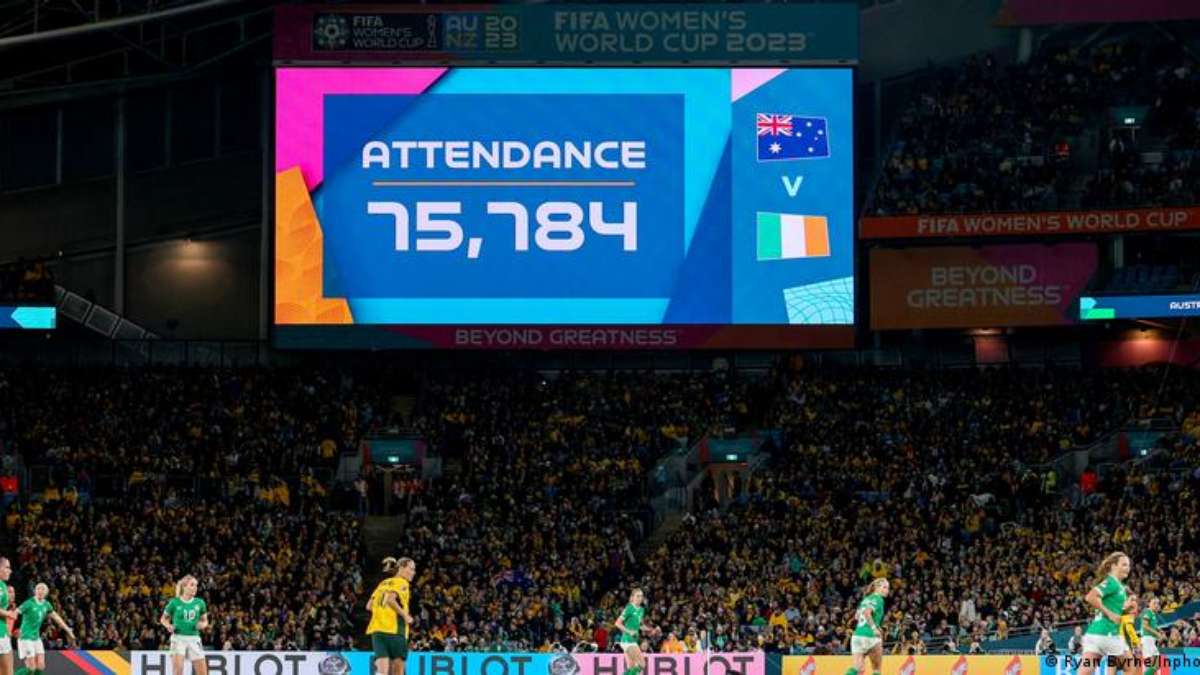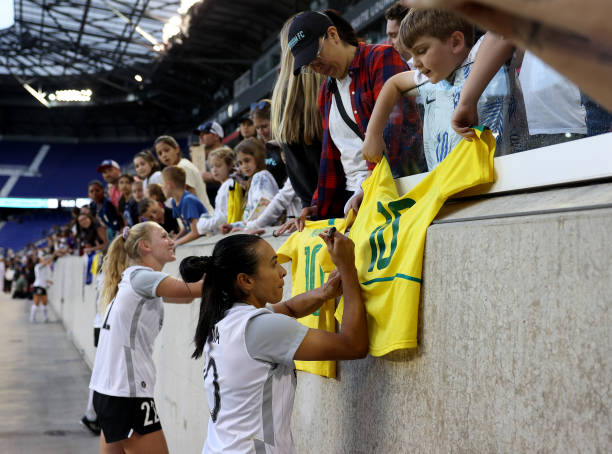
The World Cup to be hosted by Australia and New Zealand is expected to reach nearly two million tickets sold, and FIFA estimates that the global audience will reach two billion. The success should take women’s football to new heights, the noise was huge. When Hannah Wilkinson scored the winning goal for New Zealand against Norway in the opening match of the 2023 Women’s World Cup, an estimated 42,000 people were wild.
It was the largest crowd ever to attend a football match in New Zealand, either men or women, and broke the previous women’s football record of 26,000 spectators.
A few hours later, Australia followed suit, with nearly 75,000 fans cheering Team Matildas (as the Australian national team players are called) in a 1-0 victory over Ireland.
Now, with the semi-finals approaching, a total of 1.98 million tickets are expected to be sold by the end of the tournament, which equates to an average of 31,000 spectators for each of the 64 matches.
The number easily surpasses the previous record of 1.35 million people at the 2015 Women’s World Cup in Canada, which averaged 26,000 fans per match.
Given the initial target of 1.3 million – later increased to 1.5 million – the attendance is a huge success for host nations Australia and New Zealand. Football has simply exploded in both countries over the past month, and the global interest has been equally impressive.
It’s football time in Australia
Australia is a sports fanatical nation, but football has always struggled for mainstream attention compared to rugby and Australian rules football, which dominates media headlines and TV ratings.
However, the Matildas’ last 16 match against Denmark reached 6.54 million people on the Free Seven Network, which is more than the country’s biggest sporting events in 2022: the National Rugby League and the Australian Football League.
“It was amazing, it’s amazing to see all the support we’ve had, whether it’s in the stands, on TV or on live spots,” Australian defender Ellie Carpenter told DW after the match. “It’s like another person on the field.”
The figure does not include viewers of Optus Sport’s subscription streaming service, which owns the rights to all 2023 World Cup matches in the country.
Australia has shown that it really is a football nation. Approximately 1.27 million tickets will be sold by the end of the event, with an average crowd of nearly 36,000 people for each of the 35 matches in the country, with an average capacity of 93% of the venues.
“The home advantage, the home crowd, drives us through this tournament,” said player Caitlin Forward. “All the credit goes to them [os torcedores]for being loud and supportive.”
Three records broken in Auckland
Statistically, in terms of attendance, New Zealand fared slightly worse than Australia, with around 700,000 tickets sold, an average of 24,500 spectators per match.
Matches in Auckland and Wellington were well attended, but the decision to hold matches in Dunedin, which has a population of just 129,000, reduced the numbers considerably. The City Stadium has not, on average, reached 50% of capacity in its six matches, although tickets for New Zealand’s match with Switzerland have sold out.
However, with the country’s obsession with rugby and a population of just five million, the numbers exceeded expectations, with the record for the largest attendance for a football match in the country being broken three times in Auckland.
“The noise was deafening,” New Zealand captain Rhea Percival told DW after the team’s opening win over Norway. “I’ve never heard anything like this before, and I can’t believe so many people came to see us play. It was unbelievable.”
Defender Claudia Bong said: “I never dreamed of playing in front of such a packed crowd at Eden Park. I hope that some part of this history has inspired all the girls watching on the courts or at home to come out and be part of the next Generation Ferns.”
appear in the stands
Although the hosts were unable to reach the knockout stage, the New Zealanders continued to appear en masse in the stadiums for matches, carrying the flags of the teams that were still in contention.
“We’ve never seen women’s soccer before,” cheerleader Charlotte Scott told DW in Oakland. “Now we’ve seen five matches and hope there will be more.”
“We loved the excitement, the bright colors, and the music that the different audiences brought,” said Scott. “Even when the crowd is smaller, you’ll find a team like the one in Zambia, who had a choir that never stopped.”
Cynical suggestions that the free tickets may have boosted attendance do not hold, as only 20,000 of them were distributed in all four New Zealand cities hosting the matches.
TV ratings were equally impressive, especially since most of the games were shown on Sky and only a few were offered for free on Stuff.nz.
More than a million people watched the team’s opening match against Norway, more than any other Men’s World Cup match.
the world on TV
And it wasn’t just in Oceania: around the world, television stations reported impressive numbers, especially considering that many games took place outside of traditional prime time in most countries.
Although it kicked off at 5:00 a.m. ET, the United States’ shootout loss to Sweden in the Round of 16 drew 2.52 million viewers on Fox, grossing a total of 4.07 million. The four US matches averaged 3.8 million viewers, up from the first four matches of the 2019 World Cup.
The UK recorded a peak audience of 5.2 million people watching BBC One as Britain’s victory over Nigeria kicked off at 8.30am London time. There were over 2.6 million viewers watching the broadcast.
German public broadcaster ARD said 10.36 million people tuned in to watch his country’s group-stage defeat by Colombia, the highest viewership in 2023.
More than 9 million Colombians watched their team’s match against South Korea, 300% more than the previous record for a Women’s World Cup match.
Brazil’s first match against Panama was watched by 13.9 million people on TV Globo and SporTV. About 4.58 million viewers watched China’s opening match against Denmark on Chinese broadcaster CCTV5.
Australian title hopes
Given the boom in women’s football after Euro 2022 in England (which they went on to win), there were concerns that the start time of the match in the host countries, which is not very convenient for many time zones, could hurt interest.
These fears have already been allayed, showing that the appetite for women’s football follows the appetite for men’s football.
FIFA said the tournament aims to reach a total audience of two billion people worldwide, a significant increase from the 1.19 billion people the organization represented at the 2019 World Cup.
The quality of the scene was also high, even after the tournament was expanded from 24 to 32 teams to allow up-and-coming nations the chance to play against established teams.
Big results were few and far between, and several underdogs like Morocco, South Africa and Jamaica caused surprises in the group stage. Not only is the level getting better, but the gap between the best and the worst is shrinking.
There are four matches left in the tournament, but the show isn’t over yet.
Despite New Zealand’s exit, Australia still hoped to lift the trophy. If the Matildas reach the final, the TV ratings could rival the eight million viewers who watched Cathy Freeman win the 400m at the 2000 Sydney Olympics.
“It’s good to see where the sport is going here, how many girls and boys want to play football,” Fore said. “It’s nice to know the game is heading in the right direction.”

“Lifelong web fan. Incurable internet junkie. Avid bacon guru. Social media geek. Reader. Freelance food scholar.”


:strip_icc()/s02.video.glbimg.com/x720/12241213.jpg)


:strip_icc()/i.s3.glbimg.com/v1/AUTH_59edd422c0c84a879bd37670ae4f538a/internal_photos/bs/2018/7/u/KXSPFwRVSaryfLtAt7mQ/parlamentaresm-pro-brexit-questionam-se-o-acordo-garantira-2c-de-fato-2c-a-retomada-do-controle-das-fronteiras-do-territorio-britanico.-outros-que-defendem-a-permanencia-do-reino-unido-na-uniao-europeia-querem-um-novo-.jpg)
/https://i.s3.glbimg.com/v1/AUTH_bc8228b6673f488aa253bbcb03c80ec5/internal_photos/bs/2024/z/s/roAWg4QeyAreEnf8jUoA/gettyimages-1493128262.jpg)